Original crafts made from natural materials have found a permanent place in kindergartens. The relevance of such children's masterpieces from improvised means also lies in the development of fine motor skills, imagination of creators, their rapprochement with the surrounding nature, art, and labor.
Natural material for crafts
To make crafts from natural materials for kindergarten, you can use different gifts of nature at any time of the year.
The most popular ones include the following:
- branches, sticks of different sizes and shapes;
- dry, autumn leaves of different colors;
- spruce cones;
- chestnuts, acorns;
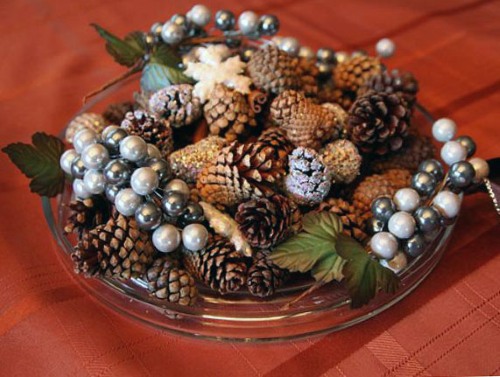
- sea/river pebbles, glass, shells;
- cereals, grain;
- vegetables, fruits;
- walnut shells, egg shells;
- seeds, etc.
What to collect and how to store
It is necessary to think about collecting natural materials for any craft in advance based on the existing ideas for implementation. This can be done during rest, stay in a kindergarten, park, forest or at a dacha, sea, etc. Involving a child in the search for suitable materials is the initial step towards joint creativity.
When choosing them, the main attention should be paid to quality, originality of forms, color palette. It is good to regenerate different ideas for creating compositions, panels, individual images, etc. Even questions from an adult about the similarity of this or that material with someone or something can become an impetus for the emergence of new images.
After each collection, it is necessary to discard any accidentally collected material with signs of mold, rot, or living creatures that have settled on it.
After this, the preparation should be thoroughly washed, dried in the sun and stored in glass containers in a dry place, and the leaves should be stored in books, thick magazines, or preserved with paraffin or glycerin.
Crafts from pine cones and chestnuts
During the preparations, it is possible to make crafts from natural materials “on the go”. You can bring freshly collected cones to the kindergarten and create an unusual composition using threads, wires/rubber bands, glue or sticks for stringing the main elements. Each of the cones can be easily decorated with other natural materials (branches, grains, acorns, ears of corn, etc.).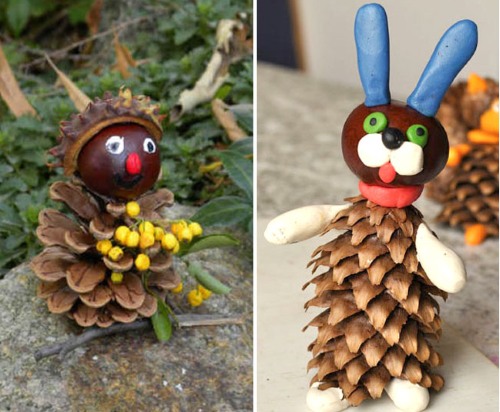
Coniferous fruits can be used whole, because they look like a body. When open, cones look great as bodies of animals and birds, and when closed, as limbs (arms, legs). Individual scales are useful for applique crafts.
Children's favorite pastime - collecting chestnuts also provides many ideas for making various crafts.
Crafting from acorns
Even autumn oak fruits – acorns – poured into a glass container can add a certain charm to the interior. Acorns with natural-colored caps covered with multi-colored varnish or acrylic paint are good for decorating ornate branches without leaves.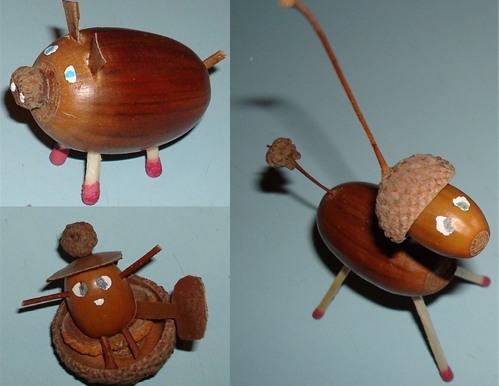
These autumn gifts of nature can be used as a whole or separately, the "body" and "hat". In addition, body parts are made from matches, branches, toothpicks. The most common crafts made from them are imitation people, forest gnomes, little owls, deer, toadstools, bunches of grapes, miniature dishes, etc.
A Family of Acorns: How to Make Little People
To make a funny family of acorns you will need:
- oak bark or a piece of oak twig;
- acorns;
- Moment glue or glue gun;
- marker (black color).
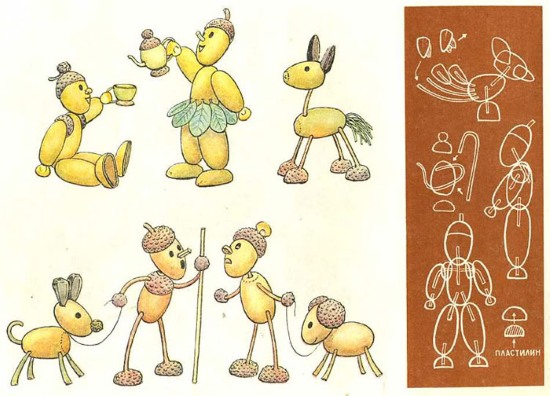
The composition is completed in just 3 steps:
- Draw funny faces on the acorns.
- Glue the hats to the "people" using "Moment".
- To attach all family members to one plane, use oak bark glued on the outside. At the same time, it must be fixed at the back to support the entire fake during the gluing process. The "little people" placed on the sticky bark must be firmly fixed.
It is important to remember that in this case, only an adult in a ventilated area in the absence of children can work with toxic glue or even a safe glue gun!
Crafts from sea shells
Shells collected on the seashore in summer, after cleaning, washing and drying, are an excellent material for decorating vases, jugs; frames; creating paintings, panels, topinaries; candlesticks, decorations, etc. Their processing consists of painting, if necessary - drilling holes with a drill, nail, hammer, needle, knife.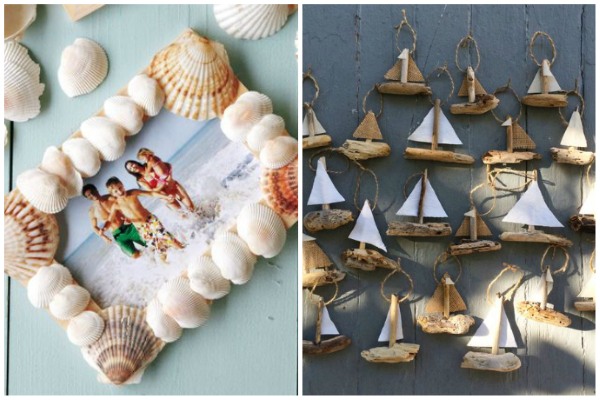
In case of chipping, sanding with sandpaper (paper, block, disk) will be required. To add shine, you can use nail polish/furniture polish, greasy cream, oil. The options for using shells in combination with different materials can be very diverse. For example, covering an oval made of plasticine with them allows you to create bird figures.
And gluing them in the desired order and color on a vase that has lost its appeal can give it a new life. It is easy to make a variety of crafts from natural materials for a kindergarten or a child's bedroom using shells.
Master class photo frame from shells
A truly original work is a photo frame framed with shells. This design involves the use of shells of different sizes, shapes and colors; glue, tape; paper to protect the area near the frame.
The work is carried out in the following order: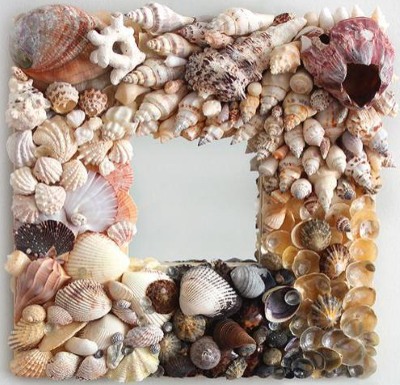
- Cover the area with the photo that is not to be decorated, securing the paper with tape.
- Sort the shells and start gluing them from the medium/small sizes from the edge of the frame near the photograph covered with paper. They can frame the frame completely, partially, in one/several rows. Decorating also allows for their combination with other materials (string, twine, branches, small driftwood, etc.).
- Continue gluing the largest shells.
- Gradually seal the free space between shells of different sizes.
- After the glue has dried, place the finished photo frame, freed from paper, in a suitable place.
Crafts from small stones, colored glass
Making crafts in kindergarten or at home from natural materials polished by the sea allows you to preserve memories of summer vacations, searching for the lucky stone - the "chicken god". The processing of each glass, stone by the jeweler-nature provides them with a unique pattern, color, texture. Such features can be successfully "played out" in different compositions, accessories, jewelry.
To transform ordinary flower pots, candlesticks, boxes, etc. into exclusive items, it is enough to artistically decorate them with these gifts of the sea.
Placing natural/colored small stones in a transparent simple vase will make it a bright accent of the interior. And small stones with magnets glued to them can take a worthy place in the existing collection.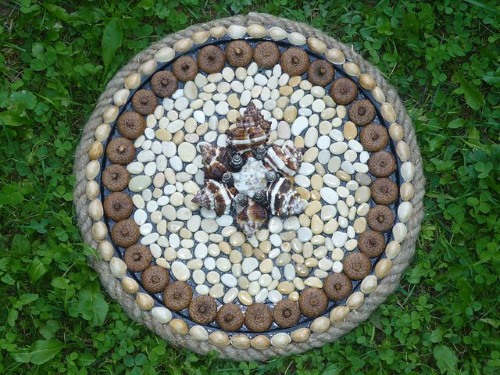
Colored glass pieces harmonize perfectly with different materials when decorating frames for paintings, photos, mirrors, as well as when creating paintings and panels.
They can be used as an applique on disposable paper plates using the following materials:
- single and multi-colored stones (small and large round);
- glass pieces of any palette;
- shells of different sizes and colors;
- scissors;
- PVA glue.
The work is carried out in this way:
- cut a circle (Ø 10 cm) in the middle of the plate;
- glue shells along the edges of the remaining whole base, and next to them, larger stones and round pieces of glass;
- Fill the remaining glued areas with small stones of different colors.
Autumn crafts from dry leaves
Drying autumn leaves of various colors and configurations seem to involve in the rapid creation of all sorts of compositions. They can be used for appliques, weaving wreaths, necklaces. Their simple execution allows improvisation regardless of the age and experience of the performers.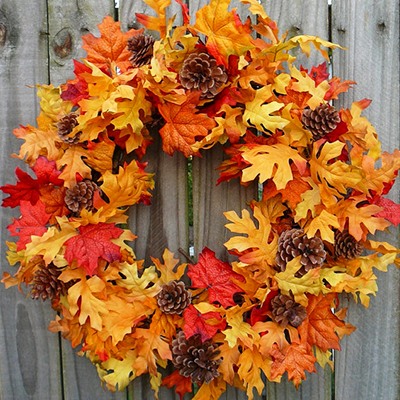
To do this, you just need to string collected leaves, for example, from a maple tree, on a thin rope, a cord and tie their ends into a knot. Despite the short "life" of these decorations, the joy of the child from creating them with his own hands does not diminish.
For a quick craft in the form of a crown of leaves, you should first make a "hoop" of thick paper up to 5 cm wide according to the volume of the baby's head. Then, double-sided tape is glued to it, to which the selected leaves are attached. Such a festive "product" can become a sign of greatness, both "queens" and "kings".
Bouquets of autumn leaves
The passion for collecting colorful tree leaves spontaneously leads to making bouquets of them. Along with varying the color and shape of the leaves in one bouquet, you can also make flowers from them.
For example, one way to create a rose from large maple leaves might be like this:
- Fold the smaller sheet in half and roll it into a tube to create the center of the flower.
- The first tube is successively wrapped with other leaves (petals) bent in half and slightly bent away from it. The fold lines are not compressed much to maintain the elasticity of these constituent particles. At the same time, each subsequent leaf should be larger than the previous one. To imitate a bud, the leaf should be folded into a corner.
- Once the rose is the desired size, the roots of the leaves are tied with thread and attached to a thin branch.
Such a blank can be used to create a whole bouquet of several roses or a composition with green and yellow leaves, chestnut fruits, rowan, viburnum, etc. To ensure greater strength and shine, it must be lightly coated with hairspray.
Crafting from twigs and sticks
Along with the use of sticks, branches for frames, fastening in a bouquet, they are often used for original interior crafts. One of them can be a simple to make composition "Autumn branch". Preparation for its execution consists only in searching for branches of interesting shapes together with the child and drying leaves from different trees in a book.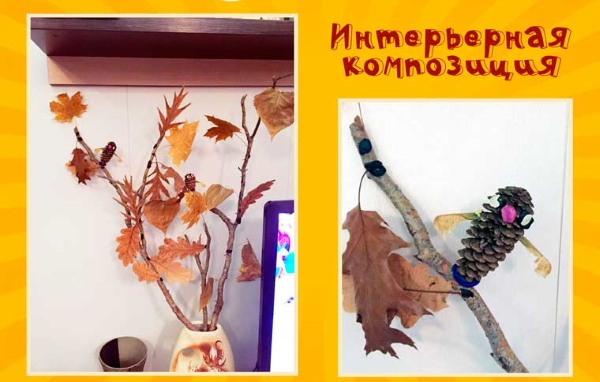
The further joint creative process consists of randomly attaching leaves to a branch with a conversation about the features of the leaves, their belonging to a specific tree. Depending on the plot, you can “settle” plasticine birds (owls, sparrows, etc.), cones, helicopters made of maple seeds, and anything else that the child’s imagination allows on the branches.
Using seeds and grains for creativity
Any seeds of sunflower, pumpkin, watermelon, melon, etc. can serve as material for crafts. They are so different in shape, size, color, texture, and are suitable for creating spring landscapes, lush flowers, paintings, appliques, etc.
Beginners can make the applique “Basket with Flowers” in the following sequence:
- draw the outline of the future basket on thick paper/cardboard and coat with glue;
fill the outline of the basket's "container" with pumpkin seeds to give the craft visual volume; - in the space between the "handle" and the top of the basket, draw your favorite flowers and then decorate them with seeds of a suitable color and texture. The centers of the flowers can be made from small grains or beads;
- After that, cover the basket with gouache or brown acrylic paint, decorate it (glitter, stickers, etc.). When adding other details, you can use plasticine.
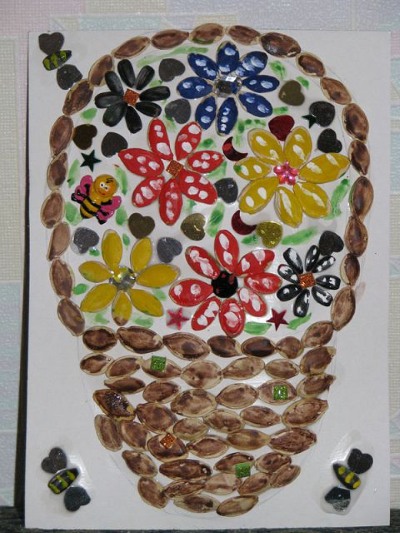
A similar technique is used to make vases, appliques, paintings with images of flora and fauna. To preserve the original appearance of the crafts for a long time, they can be covered with a thin layer of transparent varnish (for nails/hair).
DIY Cereal Crafts
Various types of cereals (buckwheat, millet, rice, semolina), legumes and even pasta can serve as materials for hand made items.
To make crafts you will need the following tools:
- thick paper (plywood, canvas),
- scissors,
- paints and brushes,
- glue,
- pattern sketches,
- decorations.

The algorithm for using grains of different textures in paintings, panels, and appliques is as follows:
- paint the base for the craft in the desired color;
- select cereals in tones that match the color scheme of the drawing and sort them separately;
- copy a sketch based on it or make a hand-drawn drawing;
- First, cover a small area of the drawing with a thin layer of glue and immediately apply the corresponding color grain to it. After fixing it on this area, remove the excess grain and continue further "drawing" in parts. The work must be completed before the glue dries completely, i.e., within 2 hours.
Panel made of natural material
A panel (translated from French – a piece of fabric) is a form of art in which individual areas of a surface are filled.
One option is to decorate them with materials of natural origin:
- shells,
- sea stones,
- leaves,
- seeds,
- cereals,
- coffee beans, etc.

They can be placed on different bases (fabric, burlap, leather, cardboard and even a wall) framed with wooden branches, decorative sticks. Among the many techniques for making panels, the most popular are decoupage with images decorated with volumetric elements and mosaic using small components.
The size and subject of the panel may vary depending on its location and the availability of materials used.
Hedgehog made of seeds and plasticine
To make such a craft, you should start by printing out a ready-made image of a hedgehog that you like or by drawing it yourself. Then generously coat its back with PVA glue and carefully attach seeds (watermelon, sunflower). Their sharp ends should point in one direction. The remaining parts (face, paws) can be painted with colored markers.
After the glue dries, attach small fruits, vegetables, and plasticine mushrooms to the "thorns" formed from the tips of the seeds. Decorate the background surrounding the hedgehog with tree leaves, small coniferous branches, and pine cones.
What can be made from coffee beans
Due to their size, coffee beans are an excellent natural material for crafts in kindergarten. Coffee beans are quite practical for creative activities, have a beneficial effect on stabilizing the nervous system, stimulating observation, thinking, and perseverance. Coffee beans look harmonious in various compositions together with other natural components.
At the same time, they can be the main material for making paintings, panels, topiaries, decorating watches, photo frames, bottles. In all variants, arbitrary arrangement of grains and their coloring are allowed. Any of these crafts will become not only a unique interior decoration, but also a long-lasting source of pleasant aroma.
Topiary (tree of happiness) made of natural material
The creators of this interior decoration in the form of a decorative tree are European florists. It is made in the eco style and has received other names: "tree of happiness", "European tree". This is one of the suitable options for those who do not respond to mutual sympathy with living plants.
In topiary you can use:
- leaves,
- dried flowers,
- shells,
- cones,
- chestnuts,
- acorns,
- peas,
- nuts,
- coffee beans, etc.
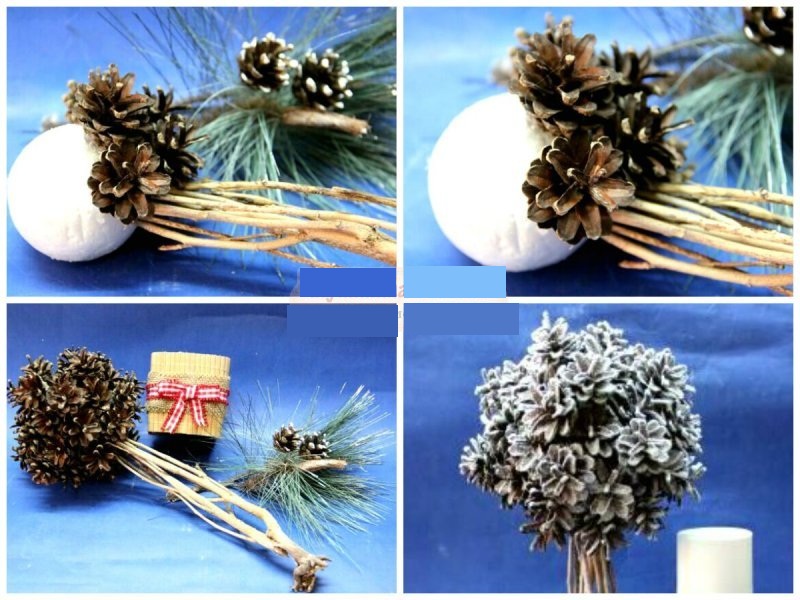
The themes of the crafts can be very different: autumn, winter, marine, etc.
Regardless of their choice, topiary requires the following basic elements:
- a trunk made of strong branches, straight tree roots with a smooth surface. If necessary, it can be decorated with paper, twine, string, fabric, thick paper;
- a blank for a spherical crown (plastic/rubber/foam balls, tennis balls, a dense lump of paper, a ball of old yarn);
- a stand in the form of any container corresponding to the size of the craft (from a cosmetics container to flower pots). If the tree of happiness is heavy, it should be filled with a gypsum/cement/alabaster solution. Its color should be restrained and in harmony with the crown. It is allowed to drape the trunk with fabric, satin ribbons.
Crafts from walnut shells
Walnut shell hemispheres can be combined both in different compositions and as independent crafts. To make a boat, just fill it with plasticine and stick a stick with a paper sail in there. With the help of coloring and a few additions, you can make a doll's cradle, an imitation of a ladybug, a frog, a snail, a hedgehog, a turtle, a giraffe, a car, etc.
Features of crafts from vegetables and fruits
A distinctive feature of crafts made from these materials is their edibility and the ability to decorate a festive table. The variety of shapes and colors of fruits allows you to create a lot of images. The shape of fruits and vegetables will help suggest different ideas. From an eggplant, for example, you can make a penguin, a duck, a turtle; from zucchini - a shark, a pig.

It is easy to turn a cucumber into Gena the Crocodile, several potatoes into Cheburashka, carrots into a giraffe, cauliflower into a sheep/poodle, a banana into an octopus/dolphin, a green pepper into a frog princess, etc. For safety reasons, it is advisable to use regular toothpicks when fastening the parts.
The use of a sharp knife requires the mandatory participation of adults during creative activities.
The proposed crafts from natural materials are far from a complete list of what can be done at home and in different groups of kindergarten. Much depends on the flight of fantasy and imaginative thinking of the performers, their inclinations to experiment with forms, texture, color.
Video: Crafts from natural materials for kindergarten
Find out how to make crafts from natural materials in the video:
Crafts from natural materials for kindergarten, autumn theme, watch the video:
